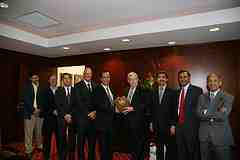Leaders with the world’s top subsea engineering programs gathered at the University of Houston last week for the first meeting of the Global Subsea University Alliance, a group dedicated to establishing worldwide standards for subsea engineering education.
The UH Cullen College of Engineering is the United States’ clear leader in subsea engineering education. It started the country’s first academic program the discipline in 2011 and in 2012 began offering the nation’s first master’s degree in subsea engineering, which focuses on the equipment and infrastructure used in the underwater portion of offshore petroleum exploration and retrieval.
Given the abundance of offshore resources and the need to extract them efficiently and safely, subsea engineering talent is in high demand. The lack of uniform standards surrounding subsea engineering education, though, can throw a wrench in petroleum companies’ recruiting and hiring process, said Matt Franchek, founding director of the subsea engineering program and a professor of mechanical engineering at the Cullen College.
“When you’re hiring a mechanical engineer, you know what you’re hiring. When you hire an electrical engineer, you know what you’re hiring. But when you hire a subsea engineer, you don’t know what you’re hiring. Everybody has their own version or variation,” he said.
The alliance seeks to remedy that problem by establishing a global subsea curriculum in coordination with companies that operate in the sector. The first step, Franchek said, is a course-by-course, lecture-by-lecture evaluation of the world’s top subsea engineering programs, all of which belong to the alliance. In addition to the University of Houston, these include programs at Curtin University in Australia, Federal University of Rio de Janero (Brazil), the National University of Singapore, the University of Aberdeen (Scotland) and the University of Bergen and the University of Stavanger (both in Norway). All were present at last week’s meeting, as were two major players in the subsea sector, Cameron and FMC Technologies.
Alliance members will then see what these programs have in common and establish a core curriculum for the discipline. They will also determine the strengths of each individual program and form committees to establish standards for specialties, such as flow assurance, subsea processing and system design and control.
Members of the alliance are also expected to offer online courses in their specialties and to allow credits to transfer among the group. These agreements will allow professional engineers to continue their subsea education even if their employer transfers them to a new location and will let students seek out the courses they believe will help them the most.
The group will also work to grow subsea engineering as an academic discipline. It will share its curriculum with other institutions looking to establish their own programs and will likely offer some form of program certification, Franchek said.
Those institutions that join the alliance will ultimately see their students benefit. If a company is given the choice between a subsea engineer who studied under a globally agreed-upon curriculum created by academics and industry verses one who didn’t, asked Franchek “which one are you going to hire? You’re going to hire the known entity rather than the unknown one. That’s what we’re trying to do for the oil and gas business and for our students.”
The launch of the Global Subsea University Alliance is just one step UH took last week to bolster its subsea program. The university also signed a Memorandum of Understanding with alliance member National University of Singapore to collaborate on education and research.
The MOU, Franchek stated, will allow UH graduate students to study in Singapore for a semester, providing them with the international experience that many oil and gas companies look for during the hiring process. Faculty with UH and NUS will also collaborate on educational and research initiatives.
Franchek noted that the agreement is not just between the two institutions’ subsea engineering programs. Instead, it is a partnership on the university-to-university level. The MOU provides a framework for UH students in essentially any discipline to study as NUS for a summer or more, and vice versa. The deal also set the stage for research collaborations across all colleges and departments at both universities.
“NUS is really a phenomenal university, and their subsea team is a first-rate group to work with,” said Franchek. “They have put major resources in building research facilities there and they feel the same drive to move forward that we do at UH. This is a great partnership for both institutions.”
Photos from the MOU signing can be seen on our Flickr page.
